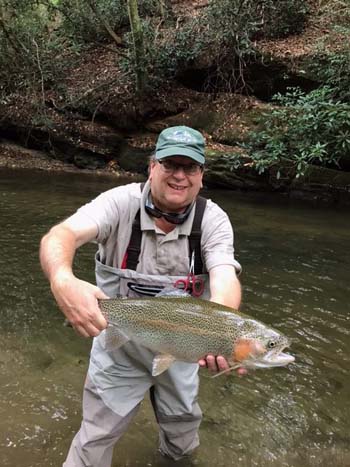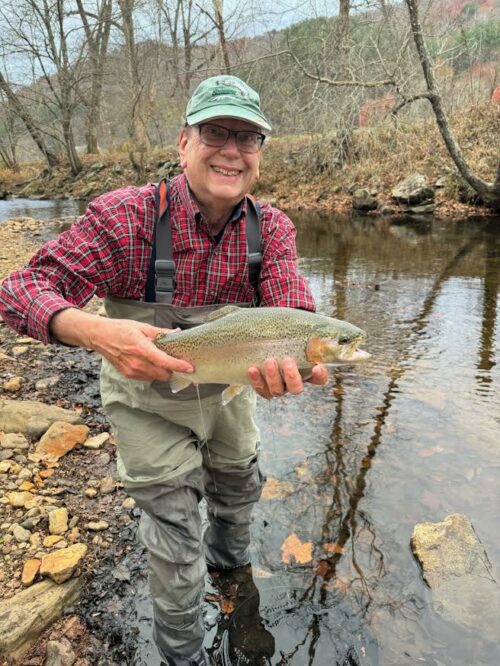
Smith Creek, Georgia.
The Rod That Came To The Rescue

Steve Hudson is the author of over 20 books. He also teaches fly casting and fly tying and has been known to build fly rods. Hudson probably knows more about southern Appalachia’s fishing and hiking than anyone.
By Steve Hudson
At this time of year, fly fishers in some parts of the country can turn to Delayed Harvest for their trout fishing.
“DH,” as it’s often called, is an approach to stream management that turns warm summertime streams into viable trout fisheries during the year’s cold months. It provides great opportunities for fine cold-weather trout fishing, and flyfishers embrace the idea with open arms.
Here in Georgia, where I live, you’ll find five great Delayed Harvest fisheries, ranging from big water (such as part of the Chattahoochee River in Atlanta) to smaller flows, such as Smith Creek up in the mountains in Unicoi State Park.
Smith Creek is one of my personal favorites
The Delayed Harvest portion lies within Unicoi State Park, and it offers a fine small-stream trout fishing experience that usually fishes well throughout the winter.
One challenge on waters such as Smith Creek is that stream geometry can be ever-changing. Sometimes, the water may be wide open with plenty of room to cast, but at other times, it may be tight and confined.
That’s a challenge for any flyfisher, especially when picking a rod for the day’s outing. It would be great if a single rod could handle those conditions, but that’s not the case. For example, a longer rod offers many advantages in open stretches. But when things tighten up, you’ll want something much shorter.
I’ve often dreamed of an easy way to change the length of my fly rod, “on the fly,” so to speak, to deal with varying conditions in real-time. But that was a dream that didn’t come true, for changing rod length is difficult to do with traditional fly tackle.
But is there a solution?
There is – and (drum roll, please) it comes from the world of tenkara. Tenkara is a traditional Japanese form of fly fishing that uses a fixed line that attaches directly to the rod’s tip. Traditionally, tenkara anglers use subsurface (wet) flies, though it can be effective with dries too. But the fly choice is another topic for another time.
Let’s look at the “rod” part of things to see how one specialized tenkara rod made all the difference on a recent trip to Smith Creek
The rod that came to the rescue is known as a “zoom” rod – a rod that can be adjusted to different lengths. I used the Fox Fire ZX-280 zoom rod from Dragontail Tenkara, a “triple-zoom” rod that can be fished at three different lengths (6.6-ft., 8-ft., or 9.3-feet). This hybrid (fiberglass with graphite) rod seems made for the small-stream angler.
On this day, I was fishing the Fox Fire with a decidedly non-traditional 10-foot PVC line (tan, with a bright orange tip) and about four feet of 5x fluorocarbon as a leader. The fly, at least at first, was a tan, Western-style bead-head soft-hackle emerger tied on a size 16 hook. There was no split shot, no strike indicator other than that orange line tip, and no reel. It was fly fishing simplicity at its finest.

Steve with a nice DH brown from Smith Creek, Georgia.
But would it work?
The first section of the creek I fished was a long, slow glide some distance below what Smith Creek regulars call “the sewer pond.” This particular piece of water (the creek, not the pond) was 30-feet long. I approached it from the downstream end, and since I had plenty of room to work with, I extended the rod to its entire length.
My first cast wasn’t exact and dropped the fly somewhere out in the middle of things – and almost instantly, almost before I knew it, the orange indicator portion of the line jumped about a foot upstream as an unseen trout came from nowhere and attacked the fly. I’d like to say I hooked up right away and landed the first fish of the day on the very first cast, but the truth is that I was watching a bird or something and missed the fish completely.
But that’s okay, I told myself
There will be more! And there were. As I worked my way up the run, I had more strikes, hooked, and landed several fish. They were a mix of rainbows and browns, and they seemed to appreciate that little tan emerger.
Conditions worsened near the top of the run as streamside vegetation crept in. Soon, I wished the rod was a little shorter – and then I remembered that it could be. It took just a second (literally a second) to shorten the rod to its intermediate length, allowing me to fish the tighter upper portion much more confidently. I was rewarded with a couple more
trout. It was turning into a good day!
I continued to work my way upstream, and things got tighter and tighter. This was the place to shorten the rod to its minimum length (again, it took only a second – and even with the 10-foot line, that was enough to let me fish that water, too.

Another DH trout from Smith Creek, Georgia.
On my third cast, another trout (a nice little brown of about 12-inches) fell for the fly. This, I decided, was fun!
I continued to fish upstream, eventually coming to what some call the “Smith Creek Marketing Department.” That’s the big pool right below the road bridge, and everyone who visits the area stops on the bridge to admire the fish that are usually visible in the water below – marketing indeed!
The Marketing department pool is wide open except for a few overhead limbs and some vegetation along parts of the bank. It was time to extend the rod to its full length, giving me the reach I needed to fish the pool effectively. Since the water was deeper here, I changed flies too and tied on a fast-sinking Perdigon.
In its longest incarnation, the Fox Fire rod cast the Perdigon with ease. The fly went deep in seconds, and the fish again gave it their seal of approval.
Later, on the way home, I thought about what the day might have been like had I fished with a fixed-length rod. In some areas, that would have been fine, but in others, I’d have found myself wishing instead of fishing. That zoom rod, however, opened up all the water. I suppose it was a dream come true, and we all need more of those.







